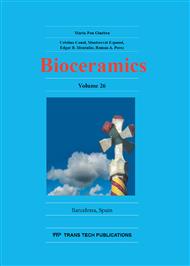p.3
p.8
p.13
p.18
p.25
p.30
p.36
p.43
Characteristics of Low Temperature Degradation Free ZTA for Artificial Joint
Abstract:
Low temperature degradation free Zirconia toughened alumina (ZTA) has been developed. It is reported that ZTA has higher mechanical strength compared to alumina due to the stress induced transformation and spontaneously transformation of zirconia phase on some ZTA have been occurred. For achieving the higher reliability of artificial joint prosthesis alternative to alumina and other ceramic materials, it is necessary to improve and validate the both mechanical characteristics and phase stability at the same time. We evaluated that microstructure, mechanical characteristics and phase stability of newly developed ZTA (BIOCERAM® AZUL). It was confirmed that four-point bending strength and weibull modulus were extreamly high, and ZTA has higher reliability. There were no significant changes and deterioration in four-point bending strength, crystal structure and wear property with and without accelerated aging test. Newly developed ZTA not only with high mechanical characteristics but also with phase stability could be quite useful as bearing materials in artificial joints for longer clinical use.
Info:
Periodical:
Pages:
18-22
Citation:
Online since:
November 2014
Price:
Сopyright:
© 2015 Trans Tech Publications Ltd. All Rights Reserved
Share:
Citation:


